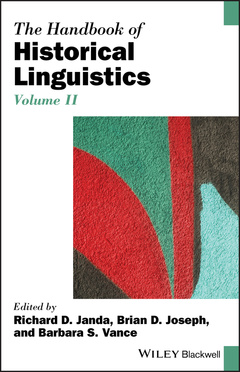Description
The Handbook of Historical Linguistics, Volume II
Blackwell Handbooks in Linguistics Series
Coordinators: Janda Richard D., Joseph Brian D., Vance Barbara S.
Language: English
704 p. · 17.5x24.9 cm · Hardback
Description
/li>Contents
/li>Biography
/li>
An entirely new follow-up volume providing a detailed account of numerous additional issues, methods, and results that characterize current work in historical linguistics.
This brand-new, second volume of The Handbook of Historical Linguistics is a complement to the well-established first volume first published in 2003. It includes extended content allowing uniquely comprehensive coverage of the study of language(s) over time. Though it adds fresh perspectives on several topics previously treated in the first volume, this Handbook focuses on extensions of diachronic linguistics beyond those key issues.
This Handbook provides readers with studies of language change whose perspectives range from comparisons of large open vs. small closed corpora, via creolistics and linguistic contact in general, to obsolescence and endangerment of languages. Written by leading scholars in their respective fields, new chapters are offered on matters such as the origin of language, evidence from language for reconstructing human prehistory, invocations of language present in studies of language past, benefits of linguistic fieldwork for historical investigation, ways in which not only biological evolution but also field biology can serve as heuristics for research into the rise and spread of linguistic innovations, and more. Moreover, it:
- offers novel and broadened content complementing the earlier volume so as to provide the fullest available overview of a wholly engrossing field
- includes 23 all-new contributed chapters, treating some familiar themes from fresh perspectives but mostly covering entirely new topics
- features expanded discussion of material from language families other than Indo-European
- provides a multiplicity of views from numerous specialists in linguistic diachrony.
The Handbook of Historical Linguistics, Volume II is an ideal book for undergraduate and graduate students in linguistics, researchers and professional linguists, as well as all those interested in the history of particular languages and the history of language more generally.
Introduction
01. Some Things Old, Some Renewed, Some on Borrowing – Here, Previewed RICHARD D. JANDA, BRIAN D. JOSEPH, AND BARBARA S. VANCE
Part I: Change within and across Core Components of Language
02. The Expanding Universe of the Study of Sound Change
FRANS HINSKENS
03. Tonogenesis: Register Tones Tone Realignment
GRAHAM THURGOOD
04. Historical Morphology – Overview and Update
BRIAN D. JOSEPH
05. Theory and Data in Historical Syntax
BARBARA VANCE
Part II: On the Variety of Methods and Foci Available for the Study of Language Change
6. Dialect Convergence and the Formation of New Dialects
PETER TRUDGILL
7. Formal Syntax as a Phylogenetic Method
CRISTINA GUARDIANO, GIUSEPPE LANGOBARDI, GUIDO CORDONI, AND PAOLA CRISMA
8. Typological Approaches and Historical Linguistics
NA’AMA PAT-EL
9. Inferring Linguistic Change from a Permanently Closed Historical Corpus
KAZUHIKO YOSHIDA
10. Studying Language Change in the Present, with Special Reference to English
LAURIE BAUER
11. Bayesian Phylolinguistics
SIMON GREENHILL, PAUL HEGGARTY, AND RUSSELL GRAY
12. Eliciting Evidence of Relatedness and Change: Fieldwork-Based Historical Linguistics
EDWARD VAJDA
13. Using Large Recent Corpora to Study Language Change,
TERTTU NEVALAINEN
Part III: Causation and Linguistic Diachrony: What Starts, Shoves, Shifts, Shapes, and/or Spreads Language Change?
14. The Phonetics of Sound Change,
ALAN C. L. YU
15. What Role Do Iconicity and Analogy Play in Grammaticalization?
OLGA FISCHER
16. Spread across the Lexicon: Frequency, Borrowing, Analogy, and Homophones
BETTY S. PHILLIPS
17. Language Acquisition, Microcues, Parameters, and Syntactic Change
MARIT WESTERGAARD
18. Theorizing Language Contact: From Synchrony to Diachrony
YARON MATRAS
Part IV: Changing Perspectives in the Study of Linguistic Diachrony
19. Genetic Creolistics as Part of Evolutionary Linguistics
SALIKOKO MUFWENE
20. Historical Change in American Sign Language
TED SUPALLA, FANNY LIMOUSIN, AND BETSY HICKS MCDONALD
21. Language Change in Language Obsolescence
ALEXANDRA Y. AIKHENVALD
22. Narrative Historical Linguistics: Linguistic Evidence for Human (Pre)history
MALCOLM ROSS
23. A Comparative Evolutionary Approach to the Origins of Cognition and of Language
MONICA TAMARIZ
24. Perturbations, Practices, Predictions, and Postludes in a Bioheuristic Historical Linguistics
RICHARD D. JANDA
Richard D. Janda is currently Visiting Scholar in French and Italian at Indiana University Bloomington, USA, but his teaching spans eleven universities in nine US states. He is author or editor of over 75 publications, including The Handbook of Historical Linguistics (Wiley Blackwell, 2003).
Brian D. Joseph is Distinguished University Professor of Linguistics and The Kenneth E. Naylor Professor of South Slavic Linguistics at The Ohio State University, USA. He has written and edited numerous books and published some 300 articles. He served as editor of the journal Language from 2002??????2009, and is currently co-editor of the Journal of Greek Linguistics.
Barbara S. Vance is Associate Professor of Linguistics and Associate Professor of French Linguistics at Indiana University Bloomington, USA. She is the author of Syntactic Change in Medieval French (1997) and is a specialist in the historical syntax of French and Occitan.




